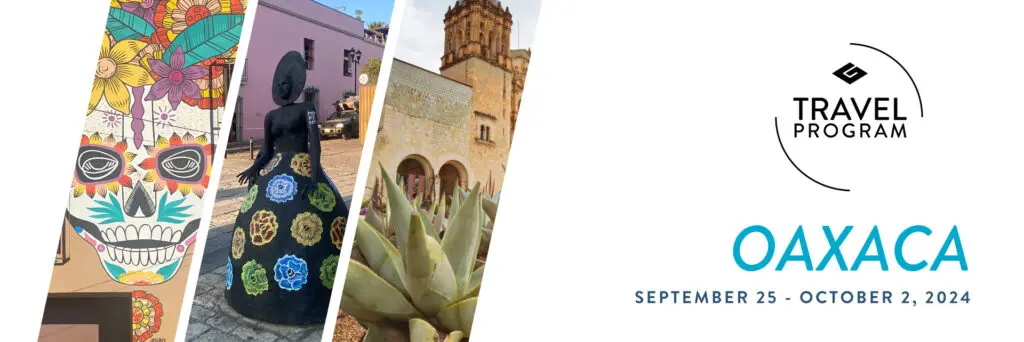Rich, fragrant mole gently ladled over a plate of spiced chicken. Aromatic chocolate freshly poured in molds. Vibrant and intricately woven textiles tell a story of indigenous traditions. Carefully-crafted ceramics lining the shelves of local shops. A glowing mass of molten glass is gracefully rolled across a stainless steel marvel. These delights and more await us in Oaxaca–a true craft lover’s paradise–for our Travel Program from September 25–October 2, 2024. If you are an aficionado of the hand-made, Oaxaca is the perfect nexus of all things craft, where ancestral techniques thrive through the careful and caring work of contemporary Oaxacans.
Mole
 When you think of authentic Mexican cuisine, you think of mole (a sauce usually made with fruits, nuts, chilis, and spices). This traditional sauce is said to have originated in Oaxaca and Puebla. Mole recipes can run the gamut from a sauce that can be prepared in 15 minutes or a labor-intensive culinary delight with complex flavors that take days to come together. Declared one of Latin America’s 50 Best Restaurants in 2021, Pitiona, named after an Oaxacan herb, takes a contemporary approach to authentic Oaxacan cuisine, including mole, and is just one of the fabulous eateries we’ll enjoy during our tour.
When you think of authentic Mexican cuisine, you think of mole (a sauce usually made with fruits, nuts, chilis, and spices). This traditional sauce is said to have originated in Oaxaca and Puebla. Mole recipes can run the gamut from a sauce that can be prepared in 15 minutes or a labor-intensive culinary delight with complex flavors that take days to come together. Declared one of Latin America’s 50 Best Restaurants in 2021, Pitiona, named after an Oaxacan herb, takes a contemporary approach to authentic Oaxacan cuisine, including mole, and is just one of the fabulous eateries we’ll enjoy during our tour.
Chocolate
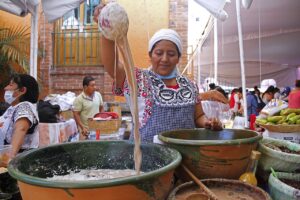 A world-favorite treat, chocolate, has its origins in Mexico! Thanks to its large Indigenous populations, traditional ways of making chocolate recipes thrive in Oaxaca. One local chocolate confection, tejate, is a rich hot chocolate beverage with notes of cinnamon that requires an hour of creation to produce a rich whipped-cream-like cocoa butter topping. There is no better place in the world to treat yourself to chocolate than Oaxaca where consuming chocolate is a cherished daily tradition. In the small village, Teotitlán del Valle, our tour will allow us to choose our adventure. We’ll have the opportunity to craft our own chocolate bars and explore textiles and ceramics.
A world-favorite treat, chocolate, has its origins in Mexico! Thanks to its large Indigenous populations, traditional ways of making chocolate recipes thrive in Oaxaca. One local chocolate confection, tejate, is a rich hot chocolate beverage with notes of cinnamon that requires an hour of creation to produce a rich whipped-cream-like cocoa butter topping. There is no better place in the world to treat yourself to chocolate than Oaxaca where consuming chocolate is a cherished daily tradition. In the small village, Teotitlán del Valle, our tour will allow us to choose our adventure. We’ll have the opportunity to craft our own chocolate bars and explore textiles and ceramics.
Textiles
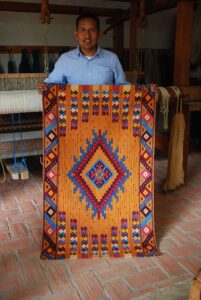 The Zapotec civilization (circa 700 BCE to 1521 CE) created their own textiles with bold, geometric, and natural patterns, and their traditions live on through the Zapotecs’ descendants today in Oaxaca. Some technological advances in weaving and dyeing have been incorporated into Zapotec textile practices, but we’ll see a variety of textiles colored with cochineal, a bright red dye found only in Oaxaca that is derived from a cactus-eating bug native to Oaxaca. One of the destinations on our journey is the Museo Textil de Oaxaca, a museum housed in a restored 18th-century mansion, which tells the story of Oaxacan textiles in a global context and preserves thousands of delicate textiles.
The Zapotec civilization (circa 700 BCE to 1521 CE) created their own textiles with bold, geometric, and natural patterns, and their traditions live on through the Zapotecs’ descendants today in Oaxaca. Some technological advances in weaving and dyeing have been incorporated into Zapotec textile practices, but we’ll see a variety of textiles colored with cochineal, a bright red dye found only in Oaxaca that is derived from a cactus-eating bug native to Oaxaca. One of the destinations on our journey is the Museo Textil de Oaxaca, a museum housed in a restored 18th-century mansion, which tells the story of Oaxacan textiles in a global context and preserves thousands of delicate textiles.
Ceramics
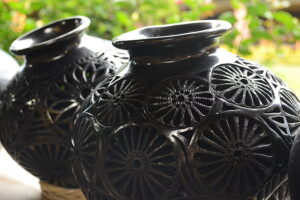 Oaxaca is known around the world for its barro negro (black clay) pottery. For most of its over thousand-year-long history, barro negro pottery was exclusively available in a gray matte finish until the 1950s when the famous ceramicist Doña Rosa polished pottery before firing it, leaving behind an alluring black glassy-like finish. Barro negro is just one of many Oaxacan pottery techniques and we are excited to explore the variety of ceramics prevalent in Oaxaca.
Oaxaca is known around the world for its barro negro (black clay) pottery. For most of its over thousand-year-long history, barro negro pottery was exclusively available in a gray matte finish until the 1950s when the famous ceramicist Doña Rosa polished pottery before firing it, leaving behind an alluring black glassy-like finish. Barro negro is just one of many Oaxacan pottery techniques and we are excited to explore the variety of ceramics prevalent in Oaxaca.
Glass
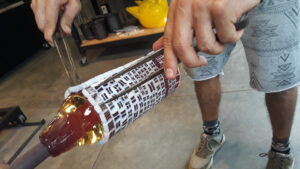
Of course, no Glass Art Society trip is complete without tours and experiences at local glass studios! Out of the five crafts we will focus on during our adventure, glass is the newcomer to the Oaxaca region and the glass studios that call Oaxaca home have a unique focus on environmentally and socially sustainable practices. One such studio is the innovative Studio Xaquixe, which is owned and operated by Salime Harp Cruces and Christian Thornton. The studio is sustainably run using biofuel, including plant waste from the studio’s own agave field. Glassmakers take mountains of discarded consumer glass and transform it into beautiful glassware and sculptures. 95% of the glass used at Studio Xaquixe is recycled post-consumer glass!
Jason Pfohl founded Gorilla Glass, an award-winning glass studio producing body jewelry in both borosilicate and soft glass, in 2002. In addition to using recycled glass, Gorilla Glass uses rainwater and reuses gray water in their farm to reduce the amount of water their facility consumes. Gorilla Glass also is committed to long-term and equitable employment options for Oaxacan women–85% of the artisans, administrators, and supervisors are women and the studio offers incredible benefits like free daycare. We are excited to shine the light on studios like Studio Xaquixe and Gorilla Glass which are actively paving the way for sustainably made glass.
Another glassy stop on our craft journey is Do Studio, owned and operated by Diego Vides Borrell. He graduated with a BFA in Industrial Design in 2010 and was an associate at The Jam Factory in Australia, learning glassmaking. Borrell’s background is evident in the work his studio produces; they use traditional Venetian glassmaking techniques to produce beautiful contemporary forms. Borrell’s work was featured in Design Week Mexico last August and he works both on his artistic work and commissioned projects. We will also enjoy visits to other regional glass studios, stay tuned for more information on those visits!
Enjoy a feast for all the senses during our Travel Program in Oaxaca this September! Claim your spot today for this exclusive craft adventure.
GAS Members: US $3,597 per person double occupancy | US $4,542 per person single occupancy
Non-Members: US $3,957 per person double occupancy | US $4,996 per person single occupancy

